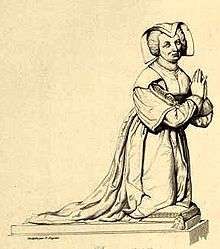Kneeling
Kneeling is a basic human position where one or both knees touch the ground. It is used as a resting position, during childbirth and as an expression of reverence and submission. It is possible to kneel with one leg and assume another position (such as squatting) with the other leg. Crouching may involve kneeling, squatting or a combination of the two.[1]
While kneeling, the thighs and upper body can be at various angles including:
- Vertical kneel: where both the thighs and upper body are vertical
- Sitting kneel: where the thighs are near horizontal and the buttocks sit on the heels with the upper body vertical - for example as in Seiza and Vajrasana (yoga).
In childbirth
The kneeling position (in combination with squatting, standing and all fours) is successfully used by midwives and traditional birth-attendants during childbirth in cultures around the world.[2]
As expression of reverence and submission
Socially, kneeling, similar to bowing, is associated with reverence, submission and obeisance, particularly if one kneels before a person who is standing or sitting: the kneeling position renders a person defenseless and unable to flee. For this reason, in some religions, in particular by Christians and Muslims, kneeling is used as a position for prayer, as a position of submission to God, although there were groups such as the Christian Agonoclites which said prayers standing and forbade kneeling. In north Indian Hindu temples, many Hindus kneel before the icon after saying a short personal prayer, and usually touch the ground with their forehead. (This is a contrast to south Indian temples, where most people prostrate completely before the icon).
In many churches, pews are equipped with kneelers in front of the seating bench so members of the congregation can kneel on them instead of the floor. In a few other situations such as confessionals and areas in front of an altar, kneelers for kneeling during prayer or sacraments may also be used.
Within the Latin Rite of Roman Catholicism, it was formerly the custom to kneel on the left knee only (genuflect) for persons of distinction (such as kings, the pope, bishops, etc.), to kneel on the right knee for the Eucharist, when it is in the tabernacle, and to kneel on both knees when the Eucharist was exposed.
Since the publication of the Roman Missal in 1973, following the reforms of the Second Vatican Council, it is customary to genuflect to the Eucharist whether reserved in the tabernacle or exposed for adoration, although in many regions the "double genuflection" (i.e. kneeling briefly on both knees) is still practiced before the exposed Eucharist. The practice of genuflecting before the Eucharist also occurs in the Anglican Church and the Lutheran Church.[3][4][5] Confirmation candidates sometimes kneel before a sitting bishop on both knees to receive the Sacrament of Confirmation and a blessing. Candidates during Holy Orders will also kneel on both before a bishop or archbishop. Sometimes penitents will kneel during confession to a priest. It is still permissible to receive the Eucharist at Communion while kneeling, although in most places it is received while standing.
In the Eastern Orthodox Church the act of kneeling, in the sense of "standing on one's knees" is not traditionally performed. Instead, there are several types of bows and prostrations. However, at his ordination, a deacon will kneel on one knee to the side of the altar, while the bishop lays his hands on the deacon's head to read the Prayer of Cheirotonia over him. A priest will kneel in the same manner at his ordination, but on both knees; and a bishop kneels (on both knees) in front of the altar as the Gospel Book is laid over his head and the consecrating bishops read the prayer.
See also
References
- ↑ Hewes GW: 'World distribution of certain postural habits' American Anthropologist, 57, (1955), 231-44
- ↑ Engelmann GJ Labor among primitive peoples (1883)
- ↑ Allen, John (1 September 2008). Desmond Tutu. Chicago Review Press. ISBN 1556527985. Retrieved 8 November 2012.
Devout "high church" Anglicans genuflect as they pass the reserved sacrament.
- ↑ Ingram, Kristen Johnson; Johnson, Kristin J (2004). Beyond Words. Church Publishing, Inc. p. 27. ISBN 0819219738. Retrieved 8 November 2012.
Episcopalians, Roman Catholics, and Lutherans may already take their souls through the slow dance of the Eucharist, kneeling, standing, genuflecting, making the sign of the cross, walking forward to receive the body and blood, walking back to the pew, standing for the last hymn.
- ↑ Armstrong, John H.; Eagle, Paul E. (26 May 2009). Understanding Four Views on the Lord's Supper. Zondervan. ISBN 0310542758.
Lutherans worship Christ wherever he is, including the sacraments, and thus Luther genuflected before the baptismal font and the sacrament.
